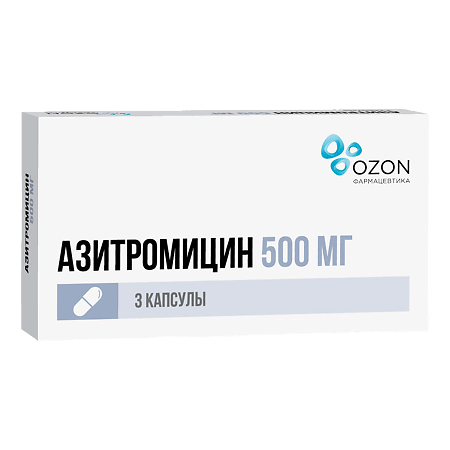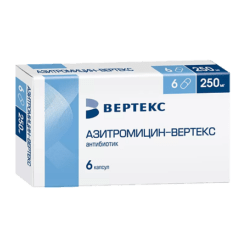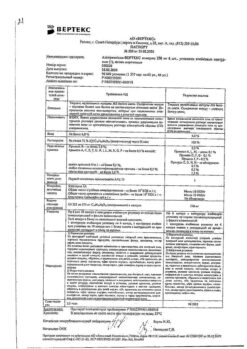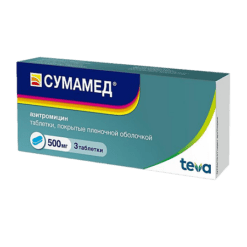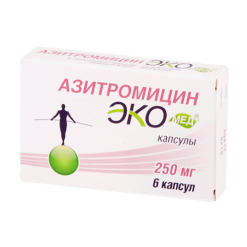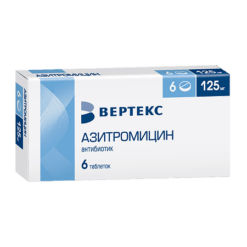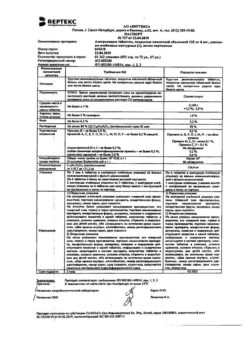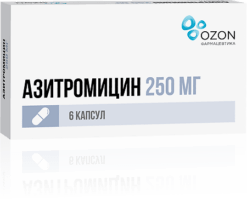No products in the cart.
Azithromycin, 500 mg 3 pcs
€4.91 €4.36
Description
Pharmacotherapeutic group: Azalid antibiotic
ATC code: J01FA10
Pharmacodynamics:
Azithromycin is a bacteriostatic broad spectrum antibiotic of the group of macrolides-azalids. It has a broad spectrum of antimicrobial action. The mechanism of action of azithromycin is associated with inhibition of microbial cell protein synthesis.
Indications
Indications
Infectious inflammatory diseases caused by microorganisms sensitive to azithromycin:
– infections of the upper respiratory tract and ENT organs (pharyngitis tonsillitis sinusitis otitis media);
– lower respiratory tract infections (acute bronchitis exacerbation of chronic bronchitis);
– community-acquired pneumonia including.
– Community-acquired pneumonia, including that caused by atypical pathogens (see “Special Indications”).
– infections of the skin and soft tissues (acne vulgaris of moderate severity rye impetigo secondary infectious dermatoses);
– initial stage of Lyme disease (borreliosis) – erythema migrans;
– urinary tract infections caused by Chlamydia trachomatis (urethritis cervicitis).
Active ingredient
Active ingredient
Composition
Composition
excipients:
Microcrystalline cellulose – 36,000 mg;
lactose monohydrate – 33,464 mg;
povidone K-30 – 26,000 mg;
crospovidone – 26,000 mg;
sodium lauryl sulfate – 1,300 mg;
colloidal silica – 6,600 mg;
magnesium stearate – 6,600 mg;
film jacket:[hypromellose – 12,000 mg, talc – 4,000 mg, titanium dioxide – 2,200 mg, macrogol 4000 (polyethylene glycol 4000) – 1,800 mg] or [dry film coating mixture containing hypromellose (60%), talc (20%), titanium dioxide (11%), macrogol 4000 (polyethylene glycol 4000) (9%)] – 20,000 mg.
How to take, the dosage
How to take, the dosage
Ingestion without chewing at least 1 hour before or 2 hours after meals once a day.
Adults and children over 12 years of age with body weight over 45 kg
Infections of the upper and lower respiratory tract ENT organs with skin and soft tissue: 1 tablet (500 mg) 1 time daily for 3 days (15 g course dose).
In acne vulgaris of moderate severity: 1 tablet (500 mg) 1 time per day for 3 days then 1 tablet (500 mg) 1 time per week for 9 weeks (course dose 60 g). The first weekly tablet should be taken 7 days after taking the first daily tablet (8th day from the start of treatment) the next 8 weekly tablets at 7-day intervals.
In Lyme disease (initial stage of borreliosis) – erythema migrans (erythemamigrans): 1 time per day for 5 days: day 1 – 10 g (2 tablets of 500 mg) then from day 2 to day 5 – 05 g (1 tablet of 500 mg) (cumulative dose of 30 g).
In case of urogenital tract infections caused by Chlamydiatrachomatis (urethritis-cervicitis): uncomplicated urethritis/cervicitis – 10 g (2 tablets of 500 mg) once.
Infections of the upper and lower respiratory tract infections of the ENT organs, skin and soft tissue: at the rate of 10 mg/kg of body weight once daily for 3 days (the course dose is 30 mg/kg). For convenient dosing it is recommended to use Table 2.
Table 2. Calculation of Azithromycin dosage for children with body weight less than 45 kg:
Body weight
Amount of azithromycin in tablets
18-30 kg
/td>
2 tablets of 125 mg (250 mg azithromycin)
31-44 kg
3 tablets of 125 mg (375 mg azithromycin)
3 tablets of 125 mg (375 mg azithromycin)/p>
at least 45 kg
prescribe doses recommended for adults
Interaction
Interaction
Antacids do not affect bioavailability of azithromycin but decrease maximum blood concentrations by 30%; therefore, azithromycin should be taken at least one hour before or two hours after taking these drugs or a meal.
Asithromycin does not affect plasma concentrations of carbamazepine cimetidine didanosine efavirenz fluconazole indinavir midazolam triazolam trimethoprim/sulfamethoxazole cetirizine sildenafil and methylprednisolone when used simultaneously. Concomitant administration of atorvastatin (10 mg daily) and azithromycin (500 mg daily) did not cause changes in concentrations of atorvastatin in plasma (on the basis of HMK-CoA reductase inhibition assay).
Special Instructions
Special Instructions
In case of missing one dose of Azithromycin, the missed dose should be taken as soon as possible and the next ones should be taken 24 hours apart. The drug Azithromycin should not be used for treatment of pneumonia in patients for whom oral therapy cannot be given due to the severity of the disease and/or who have the following risk factors: cystic fibrosis bacteremia or suspected of it states which may change the body’s response to the course of the disease (immunodeficiency, functional asphyxia, etc) patients who need hospitalization aged or weakened patients.
The drug azithromycin should be used with caution in patients with mild to moderate hepatic impairment because of the possibility of fulminant hepatitis and severe hepatic failure.
In patients with symptoms of hepatic impairment, such as rapidly increasing asthenia jaundice darkened urine bleeding tendency hepatic encephalopathy, therapy with azithromycin should be discontinued and liver function testing should be performed.
In patients with renal dysfunction of mild to moderate degree (CK values over 40 ml/min) the treatment with Azithromycin should be carried out with caution under control of renal function status. In terminal renal failure (CKR less than 10 ml/min) there is a 33 % increase of azithromycin concentration in plasma.
Microbial resistance may develop if the recommended duration of therapy is not followed. As with other antibacterial agents during therapy with Azithromycin, patients should be regularly monitored for the presence of immune microorganisms and signs of superinfections, including fungal ones.
Asithromycin should not be used over a longer course than directed, since the pharmacokinetic properties of azithromycin suggest a short and simple dosing regimen.
Penicillin is usually the drug of choice for prophylaxis of pharyngitis/tonsillitis caused by Streptococcus pyogenes and also for prevention of acute rheumatic fever.
Azithromycin may cause pseudomembranous colitis caused by Clostridiumdifficile both as mild diarrhea and severe colitis with prolonged use. If diarrhea develops during treatment with Azithromycin, as well as 2 months after therapy termination, Clostridium pseudomembranous colitis should be excluded. The use of drugs inhibiting intestinal peristalsis is contraindicated.
Delayed ventricular repolarization syndrome – prolonged QT interval syndrome increases risk of arrhythmias including “pirouette” arrhythmias during macrolide therapy and also azithromycin. Caution should be exercised when using azithromycin in patients with prolonged QT receiving therapy with antiarrhythmic agents of class IA III cisapride if hypokalemia or hypomagnesemia is clinically significant arrhythmia bradycardia or severe heart failure.
We should use caution when using azithromycin concomitantly with antipsychotic drugs (pimozide) antidepressants (citalopram) fluoroquinolones (moxifloxacin levofloxacin) cyclosporine and in elderly patients.
The use of azithromycin may provoke development of myasthenic syndrome or cause exacerbation of myasthenia gravis.
When adverse effects on the nervous system and organs of vision develop, caution should be exercised while performing activities requiring increased concentration and rapid psychomotor reactions.
Contraindications
Contraindications
– hypersensitivity to azithromycin erythromycin other ketolide macrolides or other components of the drug;
– severe hepatic impairment;
– severe renal impairment (creatinine clearance (CK) less than 40 ml/min);
– children under 12 years of age with body weight less than 45 kg (for 500 mg tablets);
– children under 3 years of age (for 125 mg tablets);
– breastfeeding period;
– concomitant administration with ergotamine and dihydroergotamine;
– lactose intolerance glucose-galactose malabsorption.
Pregnancy; myasthenia; mild to moderate hepatic dysfunction; mild to moderate renal dysfunction (CK greater than 40 ml/min); elderly patients; in patients with proarrhythmogenic factors (especially in older patients): with congenital or acquired prolongation of the QT interval in patients receiving therapy with antiarrhythmic drugs of class IA (quinidine procainamide) III (dofetilide amiodarone and sotalol) cisapride terfenadine antipsychotic drugs (pimozide) antidepressants (citalopram) fluoroquinolones (moxifloxacin levofloxacin) with disorders of water andelectrolyte balance especially in case of hypokalemia or hypomagnesemia with clinically significant bradycardia, cardiac arrhythmia or severe heart failure; concomitant use of digoxin warfarin cyclosporine.
Side effects
Side effects
The incidence of side effects is classified according to the World Health Organization recommendations: very frequently, at least 10%; frequently, at least 1% but less than 10%; infrequently, at least 01% but less than 1%; rarely, at least 001% but less than 01%; very rarely, less than 001% (including isolated cases).
Infectious diseases:
infrequent – candidiasis including oral and genital mucosa;
very rare – pseudomembranous colitis.
Metabolism and nutrition: often – anorexia.
Allergic reactions:
often – skin itching skin rash;
infrequent – hypersensitivity reactions photosensitivity reaction urticaria Stevens-Johnson syndrome angioedema;
very rare – anaphylactic reaction multiform erythema toxic epidermal necrolysis.
Blood and lymphatic system disorders:
often – eosinophilia lymphopenia;
infrequent – leukopenia neutropenia;
very rare – thrombocytopenia hemolytic anemia.
Respiratory system disorders:
infrequent – pneumonia pharyngitis respiratory diseases rhinitis dyspnea nasal bleeding.
Nervous system disorders:
often – headache dizziness paresthesia impaired sense of taste; infrequent – hypoesthesia drowsiness insomnia nervousness;
rarely – agitation;
very rare – anxiety aggression fainting seizures psychomotor hyperactivity loss of smell (or anosmia) and taste sensation myasthenia anxiety;
frequency unknown – perversion of smell delirium hallucinations.
An organ of vision: often – impairment of visual clarity.
Hearing organ and labyrinth disorders:
often – deafness;
infrequent – tinnitus hearing disorder;
rarely – vertigo.
Cardiovascular system disorders:
infrequent – sensation of palpitations “rushes” of blood to the skin of the face;
very rare – decreased blood pressure increased QT interval arrhythmia type “pirouette” ventricular tachycardia.
Gastrointestinal tract disorders:
very often – nausea flatulence abdominal pain diarrhea;
often – dyspepsia vomiting;
infrequent – constipation gastritis gastroenteritis dysphagia abdominal bloating dry oral mucosa belching oral mucosal ulcers increased salivary gland secretion;
very rare – discoloration of the tongue pancreatitis.
Liver and biliary tract disorders:
infrequent – increased activity of “hepatic” transaminases increased concentration of bilirubin hepatitis;
rare – impaired liver function;
very rare – cholestatic jaundice liver failure (in rare cases with fatal outcome mainly due to severe liver dysfunction) liver necrosis fulminant hepatitis.
Skin disorders:
infrequent dermatitis dry skin increased sweating.
Musculoskeletal and connective tissue disorders:
often – arthralgia;
infrequently – osteoarthritis myalgia back pain neck pain.
Toward the genitourinary system:
infrequent – increased concentration of urea and creatinine in plasma dysuria pain in the renal area metrorrhagia testicular function disorders;
very rare – interstitial nephritis acute renal failure. Laboratory parameters:
often – decreased plasma bicarbonate concentration increased number of: basophils monocytes neutrophils;
infrequent – increased number of platelets increased hematocrit; increased alkaline phosphatase activity increased chlorine increased plasma glucose concentration increased plasma bicarbonate concentration changed plasma sodium concentration changed potassium concentration.
Other:
often – weakness;
infrequent – chest pain peripheral edema asthenia malaise feeling of fatigue facial edema fever.
Overdose
Overdose
Symptoms: nausea temporary hearing loss vomiting diarrhea.
Treatment: symptomatic.
Pregnancy use
Pregnancy use
Similarities
Similarities
Additional information
| Shelf life | 3 years. Do not use after the expiration date. |
|---|---|
| Conditions of storage | Store in the dark place at a temperature not exceeding 25°C. Store out of the reach of children. |
| Manufacturer | Ozon, Russia |
| Medication form | pills |
| Brand | Ozon |
Other forms…
Related products
Buy Azithromycin, 500 mg 3 pcs with delivery to USA, UK, Europe and over 120 other countries.

